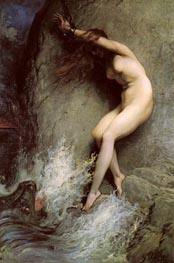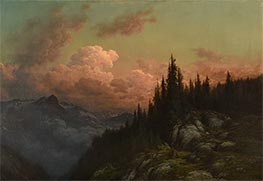
Gustave Dore Painting Reproductions 1 of 1
1832-1883
French Romanticism Painter
Gustave Doré was one of the most prolific and imaginative illustrators of the 19th century, a figure whose work transcended the boundaries of traditional art to become part of the visual fabric of literary history. Born in Strasbourg in 1832, Doré showed an extraordinary talent for drawing from a young age. By the time he was just 15, he had already begun his career as a caricaturist for the French paper "Le Journal pour rire", setting the stage for a lifetime of creativity. His early work in wood engraving laid the foundation for what would become a monumental career in illustration, especially his work for classic literature.
It was Doré’s ability to translate the written word into a vivid, almost cinematic visual experience that set him apart. His illustrations for "The Divine Comedy" by Dante, and his renderings of the Bible, are perhaps the most iconic examples of his genius. These images, etched in dark, intricate wood engravings, manage to convey both the epic scale of their stories and the intimate, often haunting, details of the human experience. His work on Dante’s "Inferno" gave the literary landscape a visual language that shaped readers' imaginations for generations to come.
In 1853, Doré was asked to illustrate the works of Lord Byron, a commission that marked the beginning of his international fame. This led to further work for British publishers, and soon he was illustrating a French edition of Cervantes’s "Don Quixote" in the 1860s. His depictions of Don Quixote and Sancho Panza became so iconic that they forever shaped how these characters were visualized in popular culture. Doré’s talent lay in his ability to capture not just the physical appearance of these figures, but the very essence of their personalities – the dreamer and the realist, side by side.
Though Doré excelled in illustration, his ambitions reached far beyond. In 1867, he had a major exhibition in London, leading to the creation of the Doré Gallery on Bond Street. His artistic output extended to painting and sculpture, though it was his wood engravings that continued to captivate the public. One of his later projects, "London: A Pilgrimage" (1872), a collaboration with journalist Blanchard Jerrold, gave a raw, often unflinching portrayal of London’s poverty. Critics, particularly in Britain, were divided. Some accused him of exaggeration, while others, like Vincent van Gogh, were deeply inspired by his work. For Doré, however, art was never about pleasing everyone, but about revealing deeper truths within the visual storytelling.
Doré died in 1883, never having married, but leaving behind a vast body of work that continues to influence artists, filmmakers, and illustrators to this day. His ability to merge the literary with the visual remains unmatched, ensuring that his work lives on not just as art but as an enduring part of cultural history.
It was Doré’s ability to translate the written word into a vivid, almost cinematic visual experience that set him apart. His illustrations for "The Divine Comedy" by Dante, and his renderings of the Bible, are perhaps the most iconic examples of his genius. These images, etched in dark, intricate wood engravings, manage to convey both the epic scale of their stories and the intimate, often haunting, details of the human experience. His work on Dante’s "Inferno" gave the literary landscape a visual language that shaped readers' imaginations for generations to come.
In 1853, Doré was asked to illustrate the works of Lord Byron, a commission that marked the beginning of his international fame. This led to further work for British publishers, and soon he was illustrating a French edition of Cervantes’s "Don Quixote" in the 1860s. His depictions of Don Quixote and Sancho Panza became so iconic that they forever shaped how these characters were visualized in popular culture. Doré’s talent lay in his ability to capture not just the physical appearance of these figures, but the very essence of their personalities – the dreamer and the realist, side by side.
Though Doré excelled in illustration, his ambitions reached far beyond. In 1867, he had a major exhibition in London, leading to the creation of the Doré Gallery on Bond Street. His artistic output extended to painting and sculpture, though it was his wood engravings that continued to captivate the public. One of his later projects, "London: A Pilgrimage" (1872), a collaboration with journalist Blanchard Jerrold, gave a raw, often unflinching portrayal of London’s poverty. Critics, particularly in Britain, were divided. Some accused him of exaggeration, while others, like Vincent van Gogh, were deeply inspired by his work. For Doré, however, art was never about pleasing everyone, but about revealing deeper truths within the visual storytelling.
Doré died in 1883, never having married, but leaving behind a vast body of work that continues to influence artists, filmmakers, and illustrators to this day. His ability to merge the literary with the visual remains unmatched, ensuring that his work lives on not just as art but as an enduring part of cultural history.
2 Gustave Dore Paintings

Andromeda 1869
Oil Painting
$1633
$1633
Canvas Print
$54.64
$54.64
SKU: DOG-3966
Gustave Dore
Original Size: 255.2 x 171.5 cm
Private Collection
Gustave Dore
Original Size: 255.2 x 171.5 cm
Private Collection

Dawn: a Souvenir of the Alps c.1880
Oil Painting
$1212
$1212
Canvas Print
$56.74
$56.74
SKU: DOG-18953
Gustave Dore
Original Size: 120 x 174.8 cm
Musee des Beaux Arts, Reims, France
Gustave Dore
Original Size: 120 x 174.8 cm
Musee des Beaux Arts, Reims, France